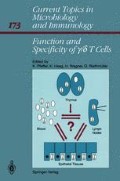Abstract
Intestinal intraepithelial lymphocytes (IEL) appear to represent a peculiar set of immune cells compartmentalized at the interface between the organism and the external environment. In previous studies we observed that within human IEL TCR-τ/δ T cells represent a major fraction that predominantly express the CD8 molecule and preferentially uses the V-δ-1 gene segment. Thus these data suggested a preferential accumulation/homing of CD8+ V-δ-1+ IEL within the human intestinal epithelium. However, to date the functional role of these cells with regard to immune regulation at this most critical immunological site is poorly understood. In this study, the cytotoxic potential and proliferative capacity of human IEL in response to mitogenic stimuli has been characterized with respect to IEL T cell receptor type and TCR-τ/δ variable gene segment usage as determined by flowcytometry. The frequeny of TCR-1+ IEL expressing both CD56 and CD16 which are considered to be NK-cell markers was found to be much higher (38.9±12.4%) than within intestinal lamina propria lympmocytes (LPL) (9.1±4.8%) or peripheral blood lymphocytes (PBL) (6.4±3.3%). In contrast, the fractions of CD16− CD56+ cells within IEL, LPL and PBL were comparable. Surprisingly, IEL mediated NK-cell activity (K562 lysis) was virtually absent whereas within PBL it was within the normal range. Furthermore, in cytotoxicity assays employing 51 Cr-labeled OKT3 hybridoma cells and P815 cells as targets, the cytotoxic potential of IEL was much lower than that of PBL. Finally, only a minority (41.9±4.4%) of TCR-τ/δ IEL were CD5+ whereas the fraction of CD5+ TCR-τ/δ LPL and TCR-τ/δ PBL were 69.8±12.8% and 82.8±8.4%, respectively. The latter finding suggests an extrathymic pathway of differentiation for TCR-τ/δ+ IEL. Taken together, our data suport the notion that human IEL represent a functionally, phenotypically and ontogenetically distinct population of cells that may regulate the local mucosal response by mechanisms different from those described for other lymphoid tissues such as peripheral lymph nodes or the peripheral blood.
Access this chapter
Tax calculation will be finalised at checkout
Purchases are for personal use only
Preview
Unable to display preview. Download preview PDF.
References
Asarnow D.M., Goodman, T., Lefrancois, L., and Allison, J. (1989) Distinct antigen receptor repertoire of two classes of murine epithelium associated T cells. Nature. 341:60.
Bucy, P., Chen, C., Cihak, J., Lösch, U., and Cooper, M. (1988) Avian T cells expressing τ/δ receptors localize in the splenic sinusoids and intestinal epithelium. J. Immunol. 141:2200.
Deusch, K. Moebius, U., Meyer zum Büschenfelde, K.H., Meuer, S.C. (1986) T lymphocyte control of autoreactivity: analysis with human T cell clones in limting dilution culture. Eur. J. Immunol. 16:1433. SS.
Deusch, K., Lüling, F, Reich, K., Classen, M., Wagner, H. and Pfeffer, K. (1991) A major fraction of human intraepithelial lymphocytes simultaneously expresses the τ/δ-TCR, the CD8 accessory molecule and preferentially uses the V-231-1 gene segment. Eur. J. Immunol. (in press).
Ebert, E.C., Roberts, A.I., Brolin, R.E., Raska, K. (1986) Examination of the low proliferative capacity ofhuman jejunal intraepithelial lymphocytes. Clin. Exp. Immunol. 65:148.
Goodman T, Lefrancois L (1987) Expression of the τ/δ-T-cell receptor on intestinal CD8+ intraepithelial lymphocytes. Nature 333:855.
Itohara, S., Farr, A.G., Lafaille, J.J., Bonneville, M., Tagakaki, Y., Haas, W., and Tonegawa, S. (1990) Homing of the τ/δ thymocyte subset with homogeneous T-cell receptors to mucosal epithelia. Nature 343:754.
Me I, Mowat, A, (1990) Human Intraepithelial Lymphocytes in: Springer Seminars in Immunopathology 12:165.
Tagakaki, Y., DeCloux, A., Bonneville, M., and Tonegawa.S. (1989) Diversity of τ/δ T cell receptors on murine intestinal intraepithelial lymphocytes. Nature. 339:712.
Author information
Authors and Affiliations
Editor information
Editors and Affiliations
Rights and permissions
Copyright information
© 1991 Springer-Verlag Berlin · Heidelberg
About this chapter
Cite this chapter
Deusch, K. et al. (1991). Phenotypic and Functional Characterization of Human TCRγδ+ Intestinal Intraepithelial Lymphocytes. In: Pfeffer, K., Heeg, K., Wagner, H., Riethmüller, G. (eds) Function and Specificity of γ/δ T Cells. Current Topics in Microbiology and Immunology, vol 173. Springer, Berlin, Heidelberg. https://doi.org/10.1007/978-3-642-76492-9_38
Download citation
DOI: https://doi.org/10.1007/978-3-642-76492-9_38
Publisher Name: Springer, Berlin, Heidelberg
Print ISBN: 978-3-642-76494-3
Online ISBN: 978-3-642-76492-9
eBook Packages: Springer Book Archive

